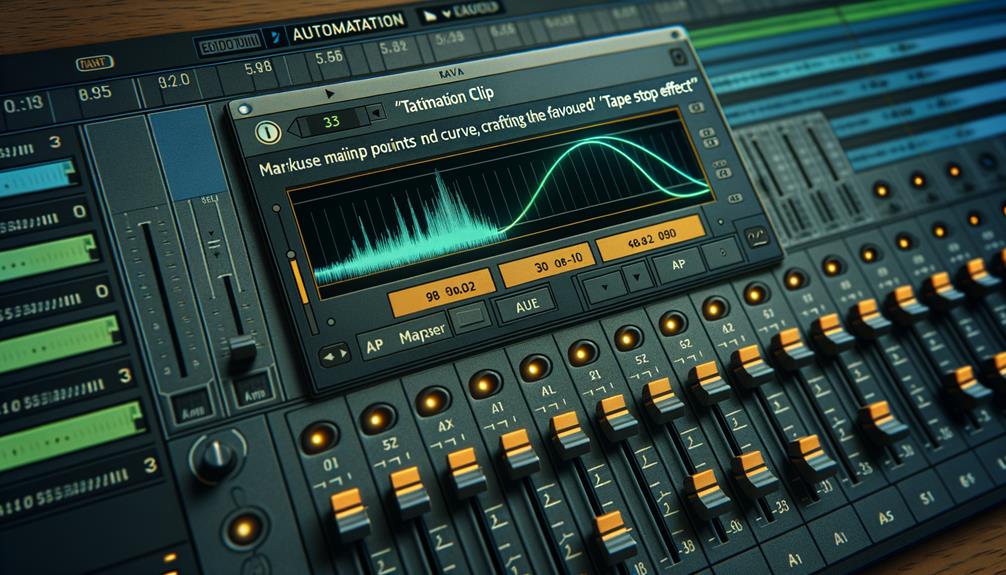No products in the cart.
So, you’re looking to add that classic tape stop effect to your tracks in FL Studio, but you’re not quite sure where to begin. Well, fear not, because with a few simple steps, you can achieve that nostalgic, warped sound that adds depth and character to your music.
Whether you’re a seasoned producer or just starting out, mastering the art of the tape stop effect can elevate your tracks to a whole new level. Let’s unlock the secrets of achieving this iconic effect in FL Studio and take your music production skills to new heights.
Contents
hide
Key Takeaways
- Gross Beat in FL Studio offers a variety of real-time and rendered performance options for creating tape stop effects, including gating, glitch, repeat, scratching, and stuttering.
- The time cursor in Gross Beat can be automated to create the tape stop effect, allowing for precise control over the timing.
- Gross Beat provides multiple parameters or slots for setting specific cues and patterns, offering unlimited creative control.
- Alternative methods for achieving the tape stop effect include using plugins like dBlue Glitch, TLs Tape Stop, Diverse Slower, Sugar Bytes Effectrix, and JB Ferox, as well as exploring FL Studio’s built-in pitch settings and automation clips.
Setting up Gross Beat in FL Studio
To set up Gross Beat in FL Studio, open an instance of Gross Beat on the effect rack for the track. Begin exploring its versatile real-time or rendered gating, glitch, repeat, scratching, and stutter performances.
Gross Beat is a powerful tool for achieving unique effects in FL Studio, such as the popular tape stop effect. Once Gross Beat is loaded onto the effect rack, you can use it to create the tape stop effect by automating the time cursor over the green graph pattern and bending it to achieve the desired effect.
Additionally, Gross Beat provides multiple parameters or slots for setting specific pre-made cues and patterns, allowing for a high level of customization and control over the effect.
Furthermore, Gross Beat’s 2-bar rolling buffer, controlled by 36 user definable time and volume envelopes, offers unlimited creative control when crafting the tape stop effect.
Applying the Tape Stop Effect
When applying the tape stop effect using Gross Beat in FL Studio, consider creating a sloping curve within the time modulation section to emulate the desired effect. This can be achieved by right-clicking to create points and using ‘single curve’ for a smooth effect.
To visualize the process:
- Open an instance of Gross Beat on the effect rack for the track in FL Studio.
- Create a sloping curve within the time modulation section to emulate a tape stop effect.
- Right-click to create points and achieve greater control over the effect by using ‘single curve’ for a smooth effect.
Additionally, creating automation for the mix knob will enable you to turn the effect on or off at specific moments, adding dynamic variation to your music productions.
It’s essential to experiment with different plugins such as dBlue Glitch, TLs Tape Stop, Diverse Slower, Sugar Bytes Effectrix, and JB Ferox to find the one that best suits your needs for the tape stop effect.
Creating Automation for the Effect

After creating a sloping curve within the time modulation section to emulate the tape stop effect using Gross Beat in FL Studio, the next step is to create automation for the mix knob to control the effect at specific moments in your track. Creating automation for the tape stop effect involves assigning the mix knob to a controller within FL Studio and then recording the desired changes in real-time or manually drawing the automation curves. Follow these steps to create automation for the tape stop effect:
| Step | Action |
|---|---|
| 1 | Open the Gross Beat plugin on the mixer track where the tape stop effect is applied. |
| 2 | Right-click on the mix knob and select ‘Create automation clip’ from the dropdown menu. |
| 3 | Use the automation clip to adjust the mix knob at specific points in the track to create the desired tape stop effect. |
Exploring Alternative Methods
Consider utilizing Illformed’s Glitch plugin as an alternative method to achieve the tape stop effect, providing the capability to incorporate retrigger or stretcher effects for a unique and dynamic sound.
When exploring alternative methods for creating the tape stop effect in FL Studio, it’s essential to consider the following options:
- Gross Beat in FL Studio: Use Gross Beat’s time cursor manipulation feature to bend the green graph pattern and achieve the tape stop effect. This method allows for precise control over the timing and pitch adjustments.
- FL Studio’s Built-in Pitch Settings: Experiment with FL Studio’s native pitch settings to create variations of the tape stop effect. Utilize automation clips to modulate the pitch and create dynamic tape stop transitions.
- Effectrix Plugin’s Vinyl Option: Explore the Vinyl option in the Effectrix plugin to quickly create the tape stop effect. Customize the effect by adjusting timing and block shapes to achieve a unique and personalized tape stop effect.
Incorporating the Tape Stop Effect Into Your Tracks


To seamlessly integrate the tape stop effect into your tracks, harness the power of Illformed’s Glitch plugin for its ability to produce chaotic and random tape stop effect blocks, adding a dynamic and unique touch to your sound. Experiment with different plugins and techniques to create a tape stop effect that complements your tracks. Utilize the table below to compare different methods for incorporating the tape stop effect into your production.
| Plugin | Features | Benefits |
|---|---|---|
| Gross Beat | Real-time or rendered effects | Unique tape stop patterns and cues |
| dBlue Tape Stop | Precise control with trigger, slowdown, and declick knobs | Fine-tune the tape stop effect for specific sections |
| Illformed’s Glitch | Chaotic and random effect blocks | Adds a dynamic and unique touch to your sound |
Incorporating the tape stop effect into your tracks can elevate the creativity and innovation in your music. Experiment with different parameters and plugins in FL Studio to achieve the desired tape stop effect, and consider watching tutorials for step-by-step instructions on using these plugins effectively. By exploring alternative methods and continuously refining your approach, you can create a tape stop effect that enhances the overall impact of your tracks.
Frequently Asked Questions
What Is a Tape Stop in Music?
A tape stop in music is a technique that involves slowing down or stopping a track to mimic the sound of a tape deck stopping. It’s achieved using popular plugins like Gross Beat or Effectrix, or through DIY methods like pitch automation. This creative effect adds excitement and variation to tracks.
How to Do Tape Stop Effect Logic?
To achieve the tape stop effect in FL Studio, utilize Gross Beat or Illformed’s Glitch. Manipulate the output by dragging the time cursor or customizing effect parameters. Experiment with these tape stop techniques for creative applications, sound manipulation, mixing tricks, and production effects.
What Is Spare State FL Studio?
Spare State FL Studio is a powerful music production software. It offers advanced tools for creating innovative sounds and effects, such as the tape stop effect. With its intuitive interface, you can easily manipulate audio to achieve unique musical expressions.
How to Do a Tape Stop on Ableton?
To achieve the tape stop technique in Ableton Live, experiment with creative effects for sound manipulation. Utilize plugins like Illformed’s Glitch or dBlue Tape Stop to add unique elements to your music production.
Conclusion
In conclusion, using Gross Beat in FL Studio to create a tape stop effect is a straightforward process.
By setting up the plugin, applying the effect, and creating automation for control, you can easily incorporate this unique effect into your tracks.
Experiment with different settings and explore alternative methods to find the perfect tape stop effect for your music production needs.




